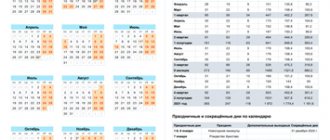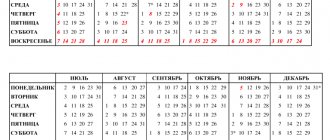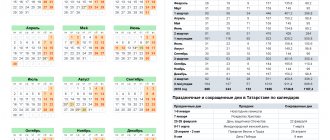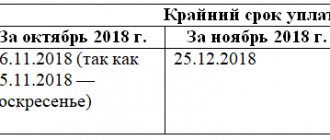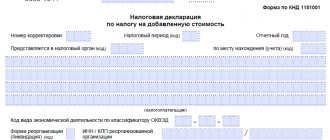The concept of a six-day working week, legislative framework
Chapter 16 of the Labor Code of the Russian Federation provides for the establishment of working hours. There is no precise definition of this concept in the legislation, however, Article 100 of the Labor Code of the Russian Federation states that the working time regime must take into account the following nuances:
- length of the work week (five-day work week with two days off, six-day work week with one day off, or work on a rotating schedule);
- irregular working hours for certain categories of workers;
- time of arrival and departure from work, including breaks;
- change of working days and days off in accordance with labor legislation, collective and labor agreements.
Regardless of work mode, the working week should not exceed 40 hours in total. However, there is an exception when a summary recording of working time is carried out - the norm of working time for a certain period (month, quarter, year) is observed.
This option is used if it is impossible to comply with the stipulated daily or monthly working hours. An organization can use a single operating mode (a five-day work week) or simultaneously use several modes (for example, one group works a five-day week with sliding days off, another group works a six-day week with one day off).
Features of a six-day work week compared to a five-day schedule
Article 111 of the Labor Code of the Russian Federation states that with a five-day working week there are two days off, and with a six-day week - one. The second day off during a five-day week is established in a collective agreement or in accordance with internal regulations, and Sunday is considered a general day off.
According to the rules, the length of the working day before a holiday is reduced by one hour. According to Article 95 of the Labor Code of the Russian Federation, with a six-day working week, the duration of work on such days cannot exceed five hours.
It is worth noting that if a weekend and a non-working holiday coincide, the first is transferred to the next working day after the holiday. Exceptions to this rule are the New Year holidays and Christmas (Part 2 of Article 112 of the Labor Code of the Russian Federation). In this case, two days off that coincided with these holidays are transferred to other days in the next calendar year.
This rule of transferring a day off that coincides with a holiday to the next working day also applies to regional holidays (Minutes No. 1 of 06/02/2014)
It is worth mentioning the length of a typical working day. With a five-day working week, it is eight hours; with a six-day working week, the number of hours per day is not clearly established, however, in practice, five days of seven hours are often set, and the sixth is five.
Production calendar for 2021 six days
By Decree of the Government of the Russian Federation dated October 14, 2017 No. 1250, the following weekends have been postponed in 2021:
- Saturday January 6 to Friday March 9 (for a six-day period this transfer does not matter - March 9 will be a regular working day);
- Sunday 7 January to Wednesday 2 May.
The Government also moved the weekend from Saturdays April 28, June 9 and December 29 to Mondays April 30, June 11 and December 31, respectively. However, with a six-day work week, Saturdays are not days off, which means that these transfers are not provided for a six-day work week.
The nuances of work on a six-day schedule under different working conditions
Irregular working hours, in accordance with the Labor Code of the Russian Federation, provide that, by order of the employer, individual employees may be involved in performing their job duties beyond the established working hours. However, such a regime can only be applied to those employees whose collective bargaining agreement or agreement contains a list of job descriptions adopted taking into account the representative body of employees.
The employee's consent to the use of such a regime is not required.
A flexible work schedule, according to Part 1 of Article 102 of the Labor Code of the Russian Federation, is an organization of working time when the beginning, end or duration of working time is established by agreement of the parties to the employment contract. In this mode, daily or monthly working hours cannot be met, so summarized working time recording is used.
The employer, in this case, must ensure that the employee works the total number of working hours during a certain accounting period.
Shift work is established when the duration of the production process is higher than the permissible norm. This mode is used for more rational use of equipment, as well as increasing the volume of products or services provided. In accordance with Article 103 of the Labor Code of the Russian Federation, each group of workers must perform their labor duties during the time established in the shift schedule.
In some types of production with unequal intensity of work throughout the working day, according to Article 105 of the Labor Code of the Russian Federation, the working day can be divided into parts. Labor legislation does not regulate their duration and quantity. The only condition remains compliance with the limits of the total working time and the prescribed duration of daily work.
Internal labor regulations are a local regulatory act that regulates hiring, dismissal, rights, duties and responsibilities of the parties, work and rest hours, types of incentives and penalties applied to the employee, as well as other issues regulating labor relations (Article 189 of the Labor Code of the Russian Federation) .
Standard hours for a six-day work week
According to Article 100 of the Labor Code of the Russian Federation, one day off is established for enterprises and organizations with a six-day working week. The general day off is Sunday (Article 111 of the Labor Code of the Russian Federation).
The normal duration of a six-day working week, like a five-day one, cannot be more than 40 hours (Article 91 of the Labor Code of the Russian Federation).
The standard working time for a six-day work week is calculated according to the calculated schedule of a five-day work week. Thus, the standard working hours in both cases are the same.
Calculation of working time standards in 2021 is carried out depending on the duration of the work shift:
- with a 40-hour work week – 8 hours;
- if the working week is less than 40 hours - the number of hours that is obtained by dividing the established working week by five.
The absence of postponements of weekends due to holidays does not in any way affect the procedure for calculating time standards, since they are calculated based on a five-day week.
Therefore, the working time standards for a six-day working week are:
- at 40 hours – 1970 hours (40 hours: 5 days × 247 days – 6 hours);
- at 36 hours – 1772.4 hours (36 hours: 5 days × 247 days – 6 hours);
- at 24 hours – 1179.6 hours (24 hours: 5 days × 247 days – 6 hours).
Roots of the problem
The Labor Code has established a general rule that the amount of time an employee must spend at work cannot exceed 40 hours per week.
This is the rule of Part 2 of Article 91 of the Labor Code of the Russian Federation. At the same time, legislators did not bother with how to divide these 40 hours into the number of working days per week. But, if we proceed from other provisions of the Labor Code that employees are usually given two days off a week (Article 111 of the Labor Code of the Russian Federation), then simply dividing forty hours into five days gives the required result - eight working hours a day. If employees work not five, but six days a week, then there is a separate rule for them - the shift on the eve of a day off cannot exceed five hours (Article 95 of the Labor Code of the Russian Federation). Accordingly, 35 hours remain for the remaining five weekdays, resulting in a seven-hour workday.
It turns out that the most common work schedules are 5x8 and 5x7+5. But if we look at any production calendar (and in practice they are used by the vast majority of accountants and personnel service employees), we will find that all calculations in it are made exclusively for a five-day work week. A logical question arises: how to calculate working hours for organizations working on a six-day schedule?
We find the answer to this question right there - in the comments that usually accompany the production calendar. It literally says the following: the Procedure for calculating the norm of working time for certain calendar periods of time (month, quarter, year) is currently in force, depending on the established duration of working time per week, approved by order of the Ministry of Health and Social Development of Russia dated August 13, 2009 No. 588n. According to the Procedure, this norm is calculated according to the calculated schedule of a five-day working week with two days off on Saturday and Sunday, based on the duration of daily work (shift). The standard working time calculated in the specified order applies to all work and rest regimes*.
So, it turns out that to determine the norm of working time during a six-day week, it is enough to take the norm from the calendar and “shift” it to six working days. However, everything turns out smoothly only on paper.
Production calendar for 2021 (6-day work week)
The following non-working holidays are established in Russia (Article 112 of the Labor Code of the Russian Federation):
- January 1, 2, 3, 4, 5, 6 and 8 — New Year holidays;
- January 7—Christmas Day;
- February 23 - Defender of the Fatherland Day;
- March 8—International Women's Day;
- May 1 - Spring and Labor Day;
- May 9 - Victory Day;
- June 12—Russia Day;
- November 4 is National Unity Day.
Weekends may be transferred to other days by federal law or a regulatory legal act of the Government of the Russian Federation (Part 5 of Article 112 of the Labor Code of the Russian Federation).
In 2021, the following transfers of weekends are provided (Government Decree No. 1250 dated October 14, 2017):
- from Saturday 6 January to Friday 9 March;
- from Sunday January 7 to Wednesday May 2;
- from Saturday 28 April to Monday 30 April;
- from Saturday 9 June to Monday 11 June;
- from Saturday 29 December to Monday 31 December.
At the same time, Saturdays April 28, June 9 and December 29 will be shortened by 1 hour according to the “pre-holiday” principle. If, in accordance with a government decision, a day off is transferred to a working day, the duration of work on this day (in this case, Saturday) must correspond to the duration of the working day to which the day off was transferred (clause 1 of the Procedure for calculating working time norms, approved by order of the Ministry of Health and Social Development of the Russian Federation dated August 13, 2009 No. 588n).
Taking this into account, we rest like this:
- The New Year holidays will last 10 days - from December 30, 2021 to January 8, 2021;
- On Defender of the Fatherland Day we will rest for 3 days - from February 23 to 25;
- on International Women's Day 4 days - from March 8 to 11;
- in May we will rest for 4 days in honor of the Spring and Labor Festival - from April 29 to May 2;
- there will be another day off on May 9 in honor of Victory Day;
- Russia Day will be marked by three weekends - from June 10 to 12;
- On National Unity Day we will also have a 3-day holiday - from November 3 to 5;
- Saturday, December 29th will have to be worked, but Monday, December 31st will be a day off.
In the Republic of Crimea, by special resolution of the head of Crimea, additional days off were approved:
- March 18 is the Day of the reunification of Crimea with Russia;
- April 17, 2021 - Easter;
- May 28, 2021 - Trinity;
- June 15, 2021 - Eid al-Adha;
- August 22, 2021 – Eid al-Adha
Calculation of standard working hours
The standard working time for certain periods (month, quarter, year) is calculated as required by Art. 91 of the Labor Code of the Russian Federation and in accordance with Order No. 588n.
So, the norm for a particular month is calculated as follows:
the length of the working week (40, 36, 24, other number of hours) is divided by 5, multiplied by the number of working days according to the calendar of the 5-day working week of this month and from the resulting number of hours the number of hours in this month for which work is carried out is subtracted reduction of working hours on the eve of non-working holidays.
Important! The standard working time calculated in this manner applies to a 6-day working week.
Thus, when drawing up a monthly schedule for a 6-day week, it is necessary to ensure that not only the weekly limit (40-, 36-, 24-hour) is observed, but also that the total number of working hours does not exceed the monthly norm calculated in the specified above order.
Holidays non-working days 2021 for Russia
Non-working holidays in Russia are (Article 112 of the Labor Code of the Russian Federation):
- January 1, 2, 3, 4, 5, 6 and 8 – New Year holidays;
- January 7 – Christmas;
- February 23 – Defender of the Fatherland Day;
- March 8 – International Women's Day;
- May 1 – Spring and Labor Day;
- May 9 – Victory Day;
- June 12 – Russia Day;
- November 4 is National Unity Day.

